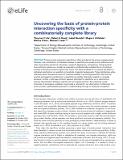Uncovering the basis of protein-protein interaction specificity with a combinatorially complete library
Author(s)
Lite, Thuy-Lan V; Grant, Robert A; Nocedal, Isabel; Littlehale, Megan L; Guo, Monica S; Laub, Michael T; ... Show more Show less
DownloadPublished version (1.844Mb)
Publisher with Creative Commons License
Publisher with Creative Commons License
Creative Commons Attribution
Terms of use
Metadata
Show full item recordAbstract
© 2020, eLife Sciences Publications Ltd. All rights reserved. Protein-protein interaction specificity is often encoded at the primary sequence level. However, the contributions of individual residues to specificity are usually poorly understood and often obscured by mutational robustness, sequence degeneracy, and epistasis. Using bacterial toxin-antitoxin systems as a model, we screened a combinatorially complete library of antitoxin variants at three key positions against two toxins. This library enabled us to measure the effect of individual substitutions on specificity in hundreds of genetic backgrounds. These distributions allow inferences about the general nature of interface residues in promoting specificity. We find that positive and negative contributions to specificity are neither inherently coupled nor mutually exclusive. Further, a wild-type antitoxin appears optimized for specificity as no substitutions improve discrimination between cognate and non-cognate partners. By comparing crystal structures of paralogous complexes, we provide a rationale for our observations. Collectively, this work provides a generalizable approach to understanding the logic of molecular recognition.
Date issued
2020Department
Massachusetts Institute of Technology. Department of Biology; Howard Hughes Medical InstituteJournal
eLife
Publisher
eLife Sciences Publications, Ltd